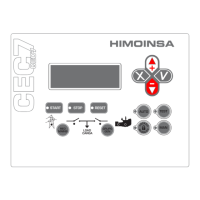OPERATION | PAGE 13
5.3 START-UP BY LOAD DEMAND
DESCRIPTION:
This function enables automatic start up and activation of generator set charging
depending on the power consumption of the network.
Start up is performed based on the programming of a maximum network power
threshold (kW) that is consumed by the installation over a certain period of time.
Once the generator set is started, the system changes genset power leaving the
network free of load.
Once the power consumed by the installation is below the set threshold and the
set time has elapsed, the system returns to charging the installation from the
network and the genset begins its stopping cycle.
With the CEC7 control unit associated to a CEM7 genset control unit (Regulations
table, parameter 30, value 0), the current measurement transformers must be
installed on the CEC7 network line (Regulations table, parameter 24, value 2) to
enable start up by load demand.
With the CEC7 control unit congured for external control of the genset
(Regulations table, parameter 30, value 2), the current measurement
transformers must be installed on the CEC7 output line (Regulations table,
parameter 24, value 1) to enable start up by load demand.
PROGRAMMING:
The generator set will start operating, providing the power supply to the
installation, when network power consumption is detected which is more than
the limit set by parameter (Threshold table, parameter 34). The genset will
continue to operate until the genset power consumption measured falls below a
limit set by parameter (Thresholds table, parameter 35). Both with the start and
stop of the genset by load demand, the conditions must be validated for a
programmable time (Times table, parameter 27). The function of start up by load
demand is only enabled in Automatic mode of the CEC7 control unit.
5.2 ENGINE STOP
The engine stopping process affects the following operation:
1. Conditions for stopping the generator set:
In automatic mode:
• Network electrical signal validation.
• RESET of network contactor activation failure alarm.
• End of programmed Start-up time period.
• Stop by load demand (see section 5.3).
In manual mode, by pressing the STOP key.
2. Switching contactors. The CEC7 control unit performs the deactivation of the
genset contactor. In automatic mode, if the network signal is correct and there is
no network contactor activation failure alarm, the control unit performs the
activation of the network contactor.
3. Cooling the engine. Once voltage free, the CEC7 control unit commands a
cooling stop of the generator set, during which the engine will continue to run for
a congurable time (Times table, parameter 11). In certain situations, it is
possible to congure the control unit alarms to perform a stop without engine
cooling.
4. Engine stop. The CEC7 control unit commands the stopping of the generator
set:
• Via the LT breaker in CEC7 control units con gured in external mode.
• Via the communications bus in CEC7 control units con gured in
integrated mode with CEM7 control units
5. Engine stopped. The CEC7 control unit checks the engine stop via the
electrical signal of the generator set.

